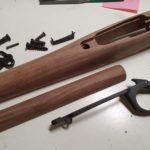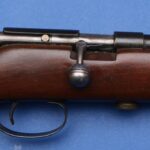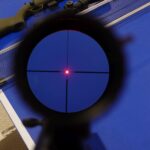A good first experience shooting is a fundamental part of getting new hunters into the tradition. Plenty of new hunters are thrown into the sport without adequate firearms training and they can be a bit of a menace to themselves and to the wildlife. I’ve seen new hunters scared of shooting a big 300 Win Mag that they’ve had handed to them and I’ve seen them make rookie mistakes like muzzle sweeping hunting buddies with a loaded firearm. It’s also my opinion that the best way to ensure that more people are tolerant of guns, and their role in hunting, is to take them for a positive experience at the range. So, I thought I’d wrap up how I introduce new people to the sport of shooting. If every hunter out there were to introduce a handful of new people to the sport in a positive, safe process, we’d be looking at much broader support and more understanding.
My process laid out below is not perfect, but I’ve found it to be very successful both 1 on 1 as well as in handling small groups of newcomers.
Step 1: The Prep
If the people you’re taking out don’t know what to expect, prepare them with a bit of knowledge in advance on items like:
- What type of clothing to wear. (especially if your range is outdoors)
- How long to expect to be at the range.
- If you’re going for a longer range session, they should probably bring snacks/water.
- What to expect in terms of range etiquette.
Some shooters may be worried about safety or recoil of the weapons. Try to address these if you get the sense that your guests may be apprehensive about them; some people don’t want to bring up that they’re scared the guns will kick and hurt them.
Step 2: The Safety Briefing
If you’re not going out to a range, you could do the safety briefing on-location. If you’re going to a range, I’d really recommend doing the safety briefing in a house. A range is loud, it’s a new environment, and your guests may not ask the questions they need to ask. Within the safety briefing, I usually break things into 3 stages:

Briefing Stage 1: Safety
- I teach the ACTS system with the simplest firearm I’ll be taking out.
- Assume every firearm is loaded.
- Control the muzzle direction at all times. (I usually use an analogy that the barrel should feel glued to a big magnet downrange and should never point away)
- Trigger finger must be kept off the trigger until ready to fire.
- See that the firearm is unloaded.
- How to correctly insert an earplug (you’d be surprised how many people who think they know how to do this right do it wrong)
- What a proper cheekweld looks like, where you should put your hands, how to use iron sights, and how to use a scope.
- I do not teach my guests how to use the manual safety on the firearms, opting instead to teach them to fire to slidelock or how to safely put down any firearm that may have jammed.
Briefing Stage 2: Show and Tell
- I personally unpack all the firearms, show inspection of each magazine and chamber, and run through basic operations of each unique firearm we’ll be taking out.
- I pull out a few snap caps if I have them, show them that they’re not real, and show how ammunition loads from a magazine and what it looks like when there’s a round in the chamber.
- I pass out the firearms, so that each guest gets a chance to handle each firearm.

Briefing Stage 3: Loading a Magazine
I don’t want to load all the mags, so I typically teach guests how to do it themselves. I separate this stage from the others to remove the possibility of my guests messing around with live rounds while there are available firearms that can fire those rounds.
- I clear any snap caps and pack away all firearms securely and pull out magazines.
- I pull out real ammo from its secure area, and show each attendee how to load a magazine, giving them a chance to load a round or two in each magazine.
- I pop the mags in my ammo case (separate from the firearms), and pack up to go.
Step 3: The Range
At the range, there are a few areas you can start: rimfire rifle, rimfire pistol, centerfire rifle, centerfire pistol, or shooting clays. Personally, I like to start my guests off with a .22 rifle. Bolt action is simple, but if all you have is a semi, that’ll work too. During their first shots with the .22, we should be focusing on trigger finger control, trigger pull, and general firearm familiarity. Your guests will quickly discover that shooting a .22 is a lot of fun!
Next, I’ll start them on a small centerfire round. 223 or 7.62X39 are nice, because you can get them on an AR15, SKS or a bolt action rifle and start hitting targets farther out. Some of your guests may be uncomfortable even with the minor recoil of the 223. Recognize it so that you don’t push them too far. If you can stretch out to 300+ yards and you have steel targets that are safe to shoot at that range, break em out. Hitting steel at 300 requires concentration and it’ll show your guests what they can do when they put their mind to the task. Keep a close eye on their trigger finger and make sure they’re staying off the trigger until it’s time to fire. It gets comfortable shooting a rifle, and some guests will forget that they’re not supposed to have their finger on the trigger all the time.
Next up, you could run through the same operations on pistols, or opt for clays. I love shooting clay pigeons, because it shows your guests that there is a level of skill involved in shooting sports. It feels great to stare down a barrel with no sights or scope at all and break your first clay pigeon! It’s almost like magic and it’s incredibly addictive. On pistols, show your guests correct grip, how to safely put a pistol down on its side and stress again to keep their finger off the trigger until they’re ready to fire.
Step 4: Post Session
There’s no real process I have on this part, but there are a few points I try to hit on the drive back. I cover some of the laws and regulations; what makes sense and what doesn’t. I want my guests to understand why magazine caps are stupid and only punish the lawful. I also explain some of the process in getting a firearms license, hunting license, what it’s like to be part of a range, etc. My basic goal is to introduce more people to the sport so they understand it, but if I can get passionate newcomers to join the sport, awesome!
Remember that this is how we build advocates for our sport and our traditions. Each of the people you introduce in a positive way will become an advocate for us. There are a small percentage of people who just despise hunting and firearms, but the vast majority of people just don’t know very much about it. Your guests will tell their friends about how safe, fun, and responsible gun ownership is, and we’ll all be better for it.





